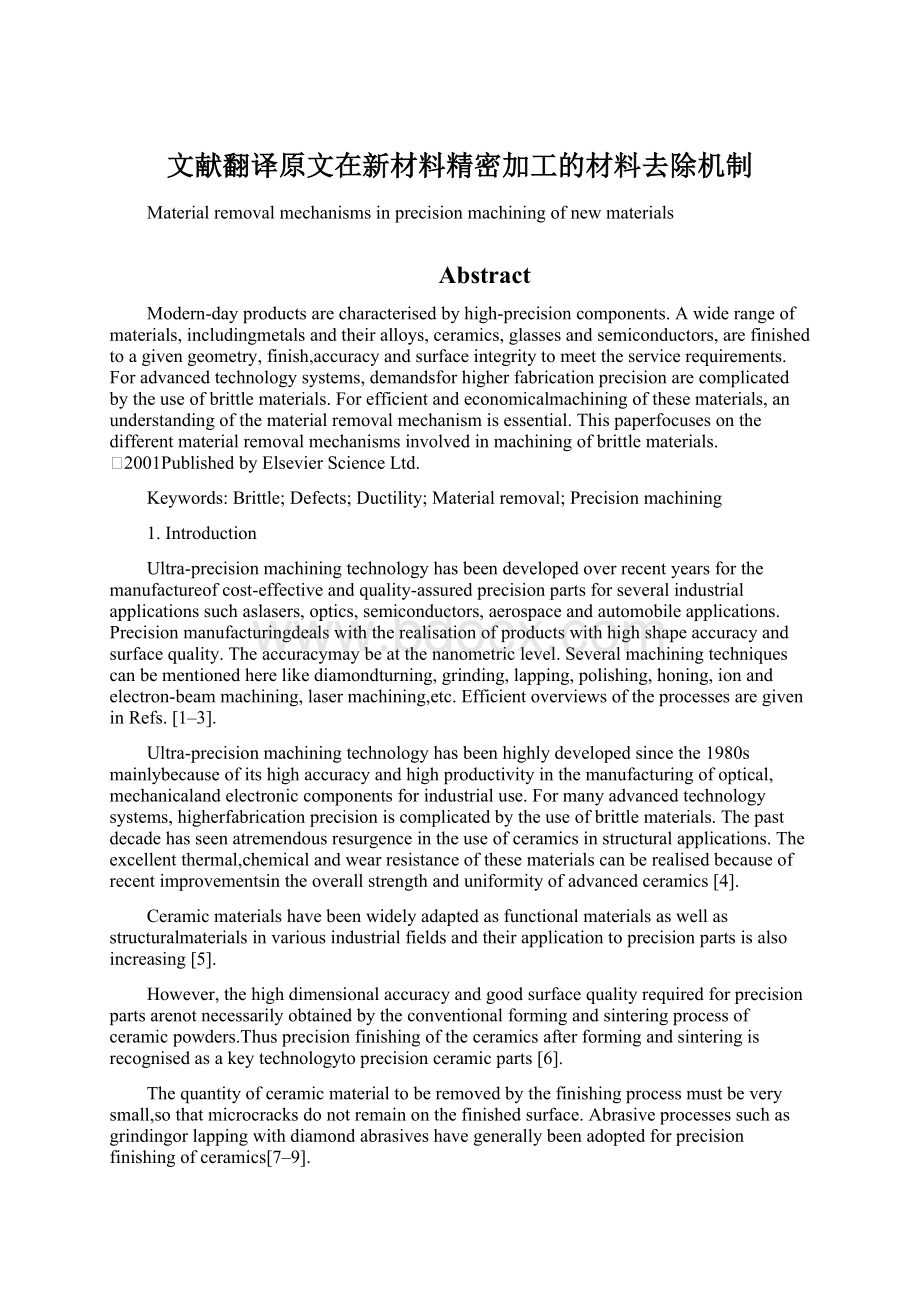文献翻译原文在新材料精密加工的材料去除机制.docx
《文献翻译原文在新材料精密加工的材料去除机制.docx》由会员分享,可在线阅读,更多相关《文献翻译原文在新材料精密加工的材料去除机制.docx(6页珍藏版)》请在冰豆网上搜索。

文献翻译原文在新材料精密加工的材料去除机制
Materialremovalmechanismsinprecisionmachiningofnewmaterials
Abstract
Modern-dayproductsarecharacterisedbyhigh-precisioncomponents.Awiderangeofmaterials,includingmetalsandtheiralloys,ceramics,glassesandsemiconductors,arefinishedtoagivengeometry,finish,accuracyandsurfaceintegritytomeettheservicerequirements.Foradvancedtechnologysystems,demandsforhigherfabricationprecisionarecomplicatedbytheuseofbrittlematerials.Forefficientandeconomicalmachiningofthesematerials,anunderstandingofthematerialremovalmechanismisessential.Thispaperfocusesonthedifferentmaterialremovalmechanismsinvolvedinmachiningofbrittlematerials.2001PublishedbyElsevierScienceLtd.
Keywords:
Brittle;Defects;Ductility;Materialremoval;Precisionmachining
1.Introduction
Ultra-precisionmachiningtechnologyhasbeendevelopedoverrecentyearsforthemanufactureofcost-effectiveandquality-assuredprecisionpartsforseveralindustrialapplicationssuchaslasers,optics,semiconductors,aerospaceandautomobileapplications.Precisionmanufacturingdealswiththerealisationofproductswithhighshapeaccuracyandsurfacequality.Theaccuracymaybeatthenanometriclevel.Severalmachiningtechniquescanbementionedherelikediamondturning,grinding,lapping,polishing,honing,ionandelectron-beammachining,lasermachining,etc.EfficientoverviewsoftheprocessesaregiveninRefs.[1–3].
Ultra-precisionmachiningtechnologyhasbeenhighlydevelopedsincethe1980smainlybecauseofitshighaccuracyandhighproductivityinthemanufacturingofoptical,mechanicalandelectroniccomponentsforindustrialuse.Formanyadvancedtechnologysystems,higherfabricationprecisioniscomplicatedbytheuseofbrittlematerials.Thepastdecadehasseenatremendousresurgenceintheuseofceramicsinstructuralapplications.Theexcellentthermal,chemicalandwearresistanceofthesematerialscanberealisedbecauseofrecentimprovementsintheoverallstrengthanduniformityofadvancedceramics[4].
Ceramicmaterialshavebeenwidelyadaptedasfunctionalmaterialsaswellasstructuralmaterialsinvariousindustrialfieldsandtheirapplicationtoprecisionpartsisalsoincreasing[5].
However,thehighdimensionalaccuracyandgoodsurfacequalityrequiredforprecisionpartsarenotnecessarilyobtainedbytheconventionalformingandsinteringprocessofceramicpowders.Thusprecisionfinishingoftheceramicsafterformingandsinteringisrecognisedasakeytechnologytoprecisionceramicparts[6].
Thequantityofceramicmaterialtoberemovedbythefinishingprocessmustbeverysmall,sothatmicrocracksdonotremainonthefinishedsurface.Abrasiveprocessessuchasgrindingorlappingwithdiamondabrasiveshavegenerallybeenadoptedforprecisionfinishingofceramics[7–9].
However,itisexpectedthatbettersurfaceintegrityandhigherproductionratescanberealisedbycuttingprocesses.Comparedwithotherprocesses,cuttingisalsoadvantageousinmachiningcomplexshapes.Brittlematerialscanbedividedintothreegroups:
amorphousglasses,hardcrystalsandadvancedceramics.Advancedceramicsareamoderndevelopment.Theyaremadefromfineporousparticlesthatareformed,consolidatedandthermallytreatedunderpreciselycontrolledconditions.Useofthesematerialsenablesdevelopmentofhigh-technologydevicesandsystemsthatsimplycouldnotbeproducedotherwise[10].
Thesamestatementcouldbemadeabouttheuseofcertaincrystallinematerials(e.g.,semiconductors)andadvancedhigh-temperatureglasses.
2.Ductileregimemachining
Improvementsinmachiningtoleranceshaveenabledresearcherstoexposetheductilematerialremovalofbrittlematerials.Undercertaincontrolledconditions,itispossibletomachinebrittlematerialslikeceramicsusingsingle-ormulti-pointdiamondtoolssothatmaterialisremovedbyplasticflow,leavingacrack-freesurface(Fig.4).Thisprocessiscalledductileregimemachining.
Ductileregimemachiningfollowsfromthefactthatallmaterialswilldeformplasticallyifthescaleofdeformationisverysmall.AnotherwayofviewingtheductileregimemachiningproblemisthatdescribedbyMiyashita[17],asshowninFig.5.Thematerialremovalratesforgrindingandpolishingarecomparedandthereisagapinwhichneithertechniquehasbeenutilised.Thisregioncanbetermedthemicro-grindinggapsincetheregionliesinbetweengrindingandpolishing.Thisgapisimportantbecauseitrepresentsthethresholdbetweenductileandbrittlegrindingregimesforawiderangeofmaterialslikeceramics,glassesandsemiconductors.
2.1.Principleofductileregimemachining
Thetransitionfrombrittletoductilemodeduringmachiningofbrittlematerialsisdescribedintermsoftheenergybalancebetweenstrainenergyandsurfaceenergy[18].Localisedfracturesproducedduringapplicationofloadareofinterestinmachiningofbrittlematerials.Machiningisanindentationprocessduringwhichindentationcracksaregenerated,andthesecracksplayanimportantroleinductileregimemachining[19].
Acriticalpenetrationdepthdcforfractureinitiationisdescribedasfollows[20]
whereKcisthefracturetoughness,Histhehardness,Eistheelasticmodulusandbisaconstantwhichdependsontoolgeometry.Fig.6showsaprojectionofthetoolperpendiculartothecuttingdirection.Accordingtotheenergybalanceconcept,fracturedamagewillinitiateattheeffectivecuttingdepthandwillpropagatetoanaveragedepthyc.Ifthedamagedoesnotcontinuebelowthecutsurfaceplane,ductileregimeconditionsareachieved.Thecross-feedfdeterminesthepositionofdcalongthetoolnose.Largervaluesoffmovedcclosertothetoolcentreline.Anotherinterpretationofductiletransitionphenomenaisbasedoncleavagefractureduetothepresenceofdefects[21].Thecriticalvaluesofacleavageandplasticdeformationareaffectedbythedensityofdefects/dislocationsintheworkmaterial.Sincethedensityofdefectsisnotsolargeinbrittlematerials,thecriticalvalueoffracturedependsonthesizeofthestressfield.Fig
7showsamodelofchipremovalwithsizeeffects.Whentheuncutchipthicknessissmall,thesizeofthecriticalstressfieldissmalltoavoidcleavage.Consequentlyatransitioninthechip
2.2.Materialremovalmechanismsinductileregimemachining
Machininggeneratesausefulsurfacebyintimatecontactoftwomatingsurfaces,namelytheworkpieceandabrasivetool.However,themicromechanismsofmaterialremovaldifferfrommaterialtomaterialdependinguponthemicrostructureofbothworkpieceandtoolmaterial.
Generally,duringhigh-precisionmachiningofbrittlematerials,toolshavinglargenegativerakeanglesareused(ashighas-30︒).Thenegativerakeangleprovidestherequiredhydrostaticpressureforenablingplasticdeformationoftheworkmaterialbeneaththetoolradius.Duringconventionalmachiningwithasingle-pointtool,therakeanglewillbepositiveorcloseto0︒.Withpositiverakeangle,thecuttingforcewillgenerallybetwicethethrustforce.Hencethedeformationaheadofthetoolwillbeinaconcentratedshearplaneorinanarrowplaneasshown
inFig.8.Duringthegrindingprocess,itisgenerallyagreedthatthetoolwillhavealargenegativerakeangleandalsothatthecuttingforceisabouthalfofthethrustforce[Fig.8(b)].Inultraprecisionmachiningofbrittlematerialsatdepthsofcutsmallerthanthetooledgeradius,thetoolpresentsalargenegativerakeangleandtheradiusofthetooledgeactsasanindenterasshowninFig.8(c).Thisrepresentsindentationslidingofabluntindenteracrosstheworkpiecesurface.ThisissimilartoasituationwherethetoolisrigidlysupportedandcutstheworkpieceunderastresssuchthatnomedianventsaregeneratedbutthematerialbelowthetoolisplasticallydeformedduetolargehydrostaticpressureasinFig.8(d).
3.Materialremovalinglassandceramics
Theductilegrindingofopticalglassisconsideredasthemostperfectadaptationofamachiningmethodtothematerial[22].Glassisaninorganicmaterialsupercooledfromthemoltenstatetothesolidstatewithoutcrystallising.Glassesarenon-crystalline(oramorphous)andrespondintermediatebetweenaliquidandasolid;i.e.,atroomtemperaturetheybehaveinabrittlemanner
1838P.S.Sreejith,B.K.A.Ngoi/InternationalJournalofMachineTools&Manufacture41(2001)1831–1843
butabovetheglasstransitiontemperatureinaviscousmanner.Thehighbrittlenessofglassisduetotheirregulararrangementofatoms.Incrystallinematerialslikemetals,theatomshaveafixedarrangementandregularitydescribedbyMillerindices,whereasglassstructuredoesnotshowanydefiniteorientation[23].
Theuniquephysicalandmechanicalpropertiesofceramicssuchashardnessandstrength,chemicalinertnessandhighwearresistancehavecontributedtotheirincreasedapplicationinmechanicalandelectricalcomponents.Theadvancedceramicsforstructuralandwearapplicationsincludealumina(Al2O3),siliconnitride(Si3N4),siliconcarbide(SiC),zirconia(ZrO2)andSiAlON.ThenatureofatomicbondingdeterminesthehardnessofthematerialaswellastheYoung’smodulus.Forductilemetallic-bondedmaterialstheratioE/Hisabout250,whileforcovalentbondedbrittlematerialstheratioisabout20.Theratiowilllieinbetweenthesevaluesforionicbondedmaterials.Lowdensityandlowmobilityofdislocationsarethereasonsforthehighhardnessofsomeofbrittlematerials.
4.Gentlegrinding
Thereisanalternativehypothesiscalled“gentle”machiningwhereinitisbelievedthatplasticdeformationisnotinvolvedexclusi